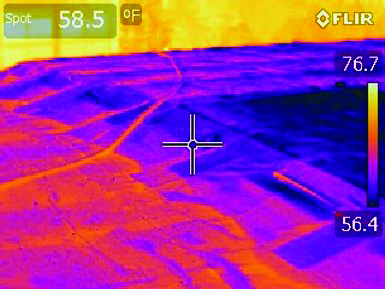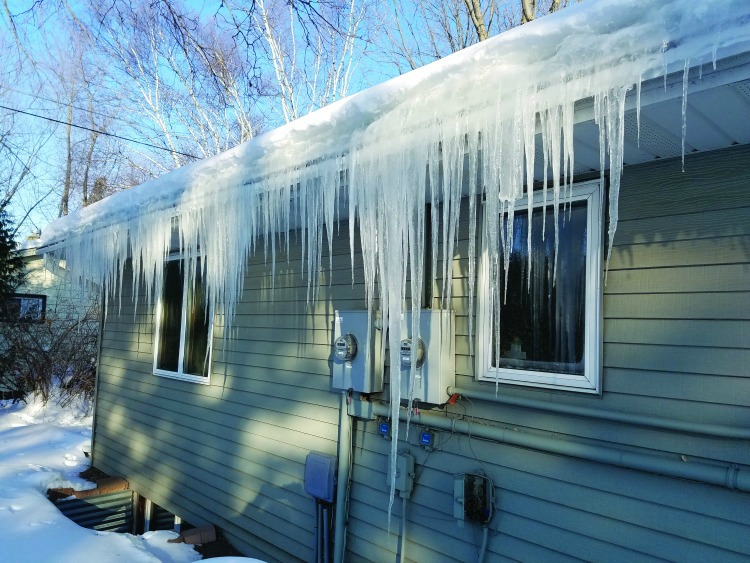Winter wreaks havoc on both low-sloped and sloped roof systems. To head off roof leaks, a walk-over review of your roof is recommended at least twice a year…
Roofs in the upper Midwest were tested to their limits this year by brutal low temperatures from the polar vortex — at a time when there was little insulating snow cover. This was followed by record snowfall piling up on area roofs by the end of February.
Even a milder winter season can wreak havoc on both low-sloped (or flat) and sloped roof systems. Ice buildup, falling chunks of ice and snow from higher roofs, and even large changes in temperatures can easily damage roof systems. Winter maintenance measures involving snow rakes and shoveling of snow, intended to protect roofing, can actually result in damage to low-slope roof systems, shingles, gutters, and flashing.
Walk-over reviews of your roof are the best way to detect problems early
To head off roof leaks, a walk-over review of your roof is recommended at least twice a year.
Spring is a time to check your roof for physical damage, as well as for damage from expansion and contraction due to the extreme change in temperatures.
Single-ply roof issues
On low-slope roofs, single-ply roof membranes are more vulnerable to physical damage but, typically, more resistant to temperature variations. Single ply membranes lose strength over time but damage from temperature changes is usually less of an issue.
In a single-ply roof spring review, check closely for physical damage at any areas where snow may have been hand-shoveled or where HVAC equipment repairs, and associated foot traffic, may have damaged flashing or membranes.
Built-up roof issues
Built-up roofs, which are very popular in the Twin Cities, are very durable and physical damage is, typically, less of an issue with this system. Built-up roofs, however, are more vulnerable to temperature variations then single-ply roof systems. As built-up roofs age, the roofing felts lose strength and lose their ability to prevent damage from expansion and contraction. Splitting of the roof membrane may occur, especially on older roofs.
In a built-up roof spring review, it’s important to look closely for any ridges or actual splits in the membrane that may have occurred through the winter.
Inspect vapor retarders
There are additional factors and more reasons to closely review your roof in spring. Most roofs now have a vapor retarder incorporated in the system to prevent vapor from escaping the building and causing condensation to form within the insulation. Although this is a good thing, vapor retarders used today are very water tight (some manufacturers even allow their use as temporary roofs during construction). A good vapor retarder will also keep any leaks that do develop from penetrating the interior of the building. The downside of this situation is that leaks can go undetected for a longer period of time, often resulting in more roof damage before being discovered.
Check for wet insulation
In addition, insulation with higher R-values are now required to meet code on both new and roof replacement projects. While that’s a good thing for reducing your heating bills, the drawback is that there is more insulation to absorb water if leaks do go undetected because of the vapor retarder. The wet insulation itself can even lead to a structural concern, due to the weight of the water, in addition to causing damage to the roof system.
A great tool to identify leak locations hiding water within the roof system is an infrared (IR) camera. Temperature differences between dry and wet roofing materials can be located and identified on an IR scan. An infrared review in spring is something that may save money from roof damage in the long run by identifying moisture within the roof system.

Troubleshoot for Ice buildup and icicles
If you experienced excessive ice buildup and icicles this winter, spring would be a good time to add additional insulation, if possible, in the attic in the area above and inside the exterior wall (without blocking ventilation routes). This is often difficult due to minimum heights at this location especially on older homes. On residential homes, heat loss near the roof eaves is a common cause of roofline icicle formation. Icicles and ice dams can block gutters and downspouts so that further ice meltwater may build up and penetrate the roof system, which often times were not designed to withstand pooled water.
When the shingle roof is eventually replaced, make sure a good ice and water sheet is installed a minimum of 3’ up slope from the exterior wall. It’s not uncommon to see the ice and water sheet applied in one row along the eave. This is not adequate and does not meet code.
An early inspection makes it easier to schedule repairs
Spring is a busy time for roof repair contractors. Detecting problems early, before contractors are over booked, will ensure that you can schedule repairs to your roof before April showers arrive.
Rick Froberg is the manager of AET’s Building Technology Division. His team at AET specialize in roof design, inspection and construction oversight on all types and sizes of roofs. He can be reached at rfroberg@teamAET.com .



